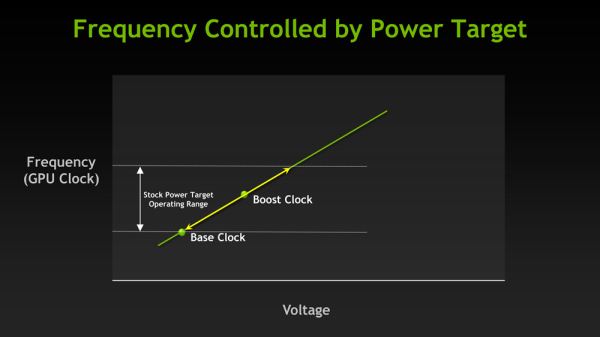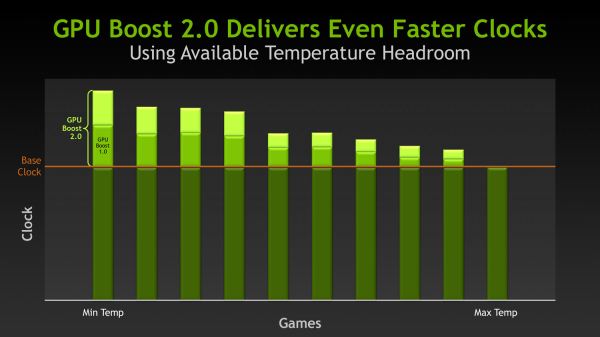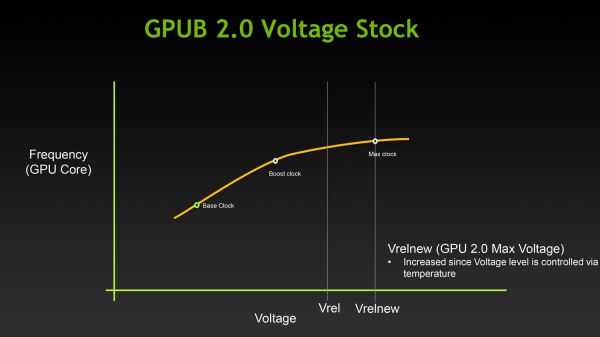NVIDIA's GeForce GTX Titan, Part 1: Titan For Gaming, Titan For Compute
by Ryan Smith on February 19, 2013 9:01 AM ESTGPU Boost 2.0: Temperature Based Boosting
With the Kepler family NVIDIA introduced their GPU Boost functionality. Present on the desktop GTX 660 and above, boost allows NVIDIA’s GPUs to turbo up to frequencies above their base clock so long as there is sufficient power headroom to operate at those higher clockspeeds and the voltages they require. Boost, like turbo and other implementations, is essentially a form of performance min-maxing, allowing GPUs to offer higher clockspeeds for lighter workloads while still staying within their absolute TDP limits.
With the first iteration of GPU Boost, GPU Boost was based almost entirely around power considerations. With the exception of an automatic 1 bin (13MHz) step down in high temperatures to compensate for increased power consumption, whether GPU Boost could boost and by how much depended on how much power headroom was available. So long as there was headroom, GPU Boost could boost up to its maximum boost bin and voltage.
For Titan, GPU Boost has undergone a small but important change that has significant ramifications to how GPU Boost works, and how much it boosts by. And that change is that with GPU Boost 2, NVIDIA has essentially moved on from a power-based boost system to a temperature-based boost system. Or perhaps more precisely, a system that is predominantly temperature based but is also capable of taking power into account.
When it came to GPU Boost 1, its greatest weakness as explained by NVIDIA is that it essentially made conservative assumptions about temperatures and the interplay between high temperatures and high voltages in order keep from seriously impacting silicon longevity. The end result being that NVIDIA was picking boost bin voltages based on the worst case temperatures, which meant those conservative assumptions about temperatures translated into conservative voltages.
So how does a temperature based system fix this? By better mapping the relationship between voltage, temperature, and reliability, NVIDIA can allow for higher voltages – and hence higher clockspeeds – by being able to finely control which boost bin is hit based on temperature. As temperatures start ramping up, NVIDIA can ramp down the boost bins until an equilibrium is reached.
Of course total power consumption is still a technical concern here, though much less so. Technically NVIDIA is watching both the temperature and the power consumption and clamping down when either is hit. But since GPU Boost 2 does away with the concept of separate power targets – sticking solely with the TDP instead – in the design of Titan there’s quite a bit more room for boosting thanks to the fact that it can keep on boosting right up until the point it hits the 250W TDP limit. Our Titan sample can boost its clockspeed by up to 19% (837MHz to 992MHz), whereas our GTX 680 sample could only boost by 10% (1006MHz to 1110MHz).
Ultimately however whether GPU Boost 2 is power sensitive is actually a control panel setting, meaning that power sensitivity can be disabled. By default GPU Boost will monitor both temperature and power, but 3rd party overclocking utilities such as EVGA Precision X can prioritize temperature over power, at which point GPU Boost 2 can actually ignore TDP to a certain extent to focus on power. So if nothing else there’s quite a bit more flexibility with GPU Boost 2 than there was with GPU Boost 1.
Unfortunately because GPU Boost 2 is only implemented in Titan it’s hard to evaluate just how much “better” this is in any quantities sense. We will be able to present specific Titan numbers on Thursday, but other than saying that our Titan maxed out at 992MHz at its highest boost bin of 1.162v, we can’t directly compare it to how the GTX 680 handled things.













157 Comments
View All Comments
CeriseCogburn - Thursday, February 21, 2013 - link
Congratulations to all you whining amd fanboy freaks who lost the POINT of the rebuttal....Some amd fruitcake OWS idiot squealed profits are going through the roof (jhonny dough boy)...
It was pointed out AMD is a failing, debt ridden, dying, sack of in the red losses loser company just about blwon to bankruptcy smithereens...
But then when do amd fanboys pay attention to their helping hand demise of their big fave AMD ?
Answer: NEVER
Reason: They constantly beg and bag for lower pricing and squeal amd does just that every time. Then they wait for nVidia to DESTROY amd pricing with awesome nVidia hardware... at that point they take their pauper pennies and JUMP on that AMD card-- raping the bottom line into more BILLIONS of losses for amd, while they attack nVidia and scream corporate profit...
LOL
Moral of the history and current idiocy of the flapping lipped fools who get it 100% incorrect while they bloviate for their verdetrol master amd.
The amd fanboys have just about destroyed amd as a going venture...
I congratulate the clueless FOOLS for slaying the idiot crash monkey lousy video card junk producer amd.
Scott586 - Thursday, February 21, 2013 - link
Wow TheJian, shut up already. We stopped reading 1/2-way thru the 2nd sentence.Spunjji - Thursday, February 21, 2013 - link
Thanks for taking what was a relevant comment correcting the previous poster and turning it into an inaccurate, ill-informed vitriolic rant about politics. That was... unprecedented.CeriseCogburn - Sunday, February 24, 2013 - link
I enjoyed it, a lot. It was not however unprecedented, mr liar.As I so clearly recall, very recently on another little review here, the left wing raging amd fan OWS protester went on a wild diatribe cursing out those who dared not use their powerful system to organize political action and other such ventures like curing cancer, thus "disusing" their personal systems...
So no, the wacko collectivist beat him to it.
BurtGravy - Thursday, February 21, 2013 - link
That escalated quickly.iEATu - Wednesday, May 29, 2013 - link
I stopped reading when you started talking about Reagan and cutting taxes creates businesses. Based off of history with Reagan, revenue did NOT come in because big businesses took advantage of the tax cuts and nothing changed except to make big business more powerful and the richest people richer.3DPA - Saturday, August 10, 2013 - link
Wow....this certainly got off topic. The only hope for America is for the US to became a tax haven for the rest of the world...similar to what Singapore did (and they are hugely prosperous). When you factor in under funded pensions, social security and medicare, the real US debt comes to around $86 trillion. You need to drop the US corporate tax rate from the highest in the world (I think around 30% to 35%) to the lowest. When you look at electronics manufacturing, the cost of building off-shore in China really only saves you 7% in labor because 90% of electronic assembly is automated. So you save 7%, but then you lose 4% shipping it back to the US thanks to the price of oil. So you really end up saving 3%. Given all the hassles of dealing with manufacturing half-way around the world, 3% savings is really not that attractive. So why do companies move electronics manufacturing over-seas? Because they save on tax...to the tune of 10% to 15%. You want to bring electronics manufacturing jobs back to the US? Just lower the corporate tax rate to something more globally competitive like 15% to 20%. This will create HUGE influx of job growth in the US. And what happens when more people are working? You broaden the tax base so tax revenue increases. Also, remember that close to $1 Trillion of corporate profits is sitting in foreign banks ($100 Billion of that belongs to Apple) because they don't want to pay the huge US corporate tax rates. Lower that tax rate and all that money flows back into the US where it can be used for investment in the US...which creates more opportunity...etc....etc...etc...So don't believe it when the Obama administration can't solve the US debt issue. It can be solved. But it just kills a socialist/communist president to cut corporate America a break even though not to do so causes us even more harm.
You know.....I have yet to meet anyone that actually thinks Obama is doing a good job or is good for the country. I hear more negative talk, more jokes, seen more negative books published about him and heard more dooms-day scenarios with his name at the middle of it than any other president in memory.
So how did he get re-elected?
Well...there is one good thing I can say about Obama: He made me appreciate Bill Clinton.
azixtgo - Sunday, November 10, 2013 - link
higher prices mean fewer sales. Lower prices mean lower margins. They have to find some balance and I doubt anyone here knows enough to know where that balance is. My thinking is that both companies make too many chips (desktop market). They price desirable chips too high for the average person. Maybe they should make fewer chips and make upgrades more desirable.Both consoles have sold millions already. I doubt it will be that game changing for them. Another thing is that AMD is letting their desktop CPU market suffer. They have not put out better chipsets for their FX processors in a good while so even people who would buy the fx processors may not do so when they see what they get with the motherboard (they do not even have mATX motherboards for these processors AFAIK.) I doubt the APUs will make up for the FX shortfalls. Intel on the other hand offers a less complicated setup. Companies do not just lose profits on lower prices and I am inclined to think the prices can stand to be lower based on what both nvidia and amd have done recently
eg. 280X is a 7970 being sold for $300. GTX 780 now sells for 499. Are they at the balance point? I don't know. i just don't think they are optimizing their market presence at all
Sabresiberian - Wednesday, February 20, 2013 - link
No, the GK110 isn't cheaper to produce, not by a long shot, and Intel's profit margin for their CPUs are quite a bit higher than Nvidia's or AMD's for the graphics solutions. It's pretty amazing considering the GPUs are far bigger.I was hoping for a price around $800, but expecting it to be $900-1200. Sure, I wish it was less, but Nvidia isn't out of line here.
CeriseCogburn - Sunday, February 24, 2013 - link
I agree. It's quiet, it sips power, it's the fastest, it has the features amd lacks, which are many and considerable. It has stable drivers, it is well built, it has 6G of ram, thus making it the most future proof to date, just recently of utmost importance to all the amd fanboys 3G quacking Skyrim mods baggers, now they can eat dirt, then mud from the delicious tears.Yeah pretty sick of the constant CEO price "absolutears" here on every dang release, squealing out price perf bang for buck whines and lies and pauper protestations in betwixt bragging about their knowledge and prowess and spewing fanboy fave.
If you're a fanboy get off your butt and toss a few papers so you can buy a ding dang video card without wailing like a homeless vagrant.